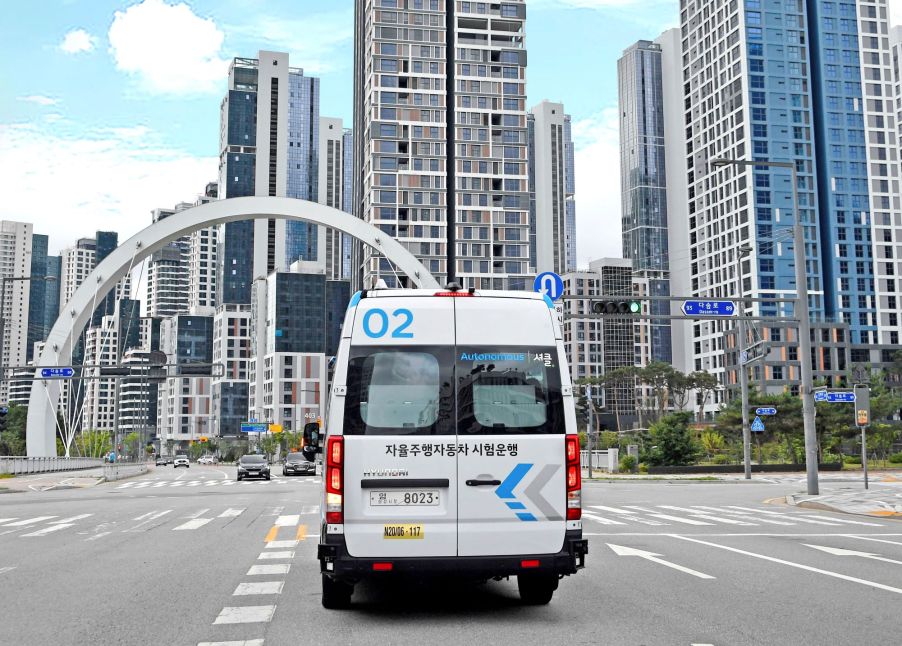
Hyundai Announces Autonomous ‘RoboShuttle’ Service in South Korea
We may not be living in a world of flying cars just yet, but autonomous vehicles are certainly gaining a lot of traction. Hyundai‘s latest endeavor might bring things one step closer to such a self-driving reality. Autonomous driving technology continues to advance in a big way, and the Hyundai “RoboShuttle” intends to improve commuting life in South Korea sooner than you might think. Furthermore, should Hyundai’s autonomous driving experiment prove successful, there could be far-reaching implications for commuters everywhere.
Hyundai dips a toe in the autonomous driving pool with ‘RoboShuttle’

The Hyundai Motor Company, like other automakers, is exploring autonomous driving initiatives. With a brand vision the company calls “Progress for Humanity,” the popular carmaker is accelerating a transformation into becoming a Smart Mobility Solution Provider. According to Hyundai, new investments into robotics and Urban Air Mobility (UAM) aim to revolutionize how people engage in transportation. Sustainability is the name of the game, too, as Hyundai also strives to introduce zero-emission vehicles using EV and hydrogen fuel cell technology.
Last year, Hyundai announced an autonomous vehicle driving venture with Aptiv to develop a self-driving solution for ride-hailing. The Verge also reported that Hyundai invested $1.6 billion to catch up in the autonomous driving segment. Additionally, earlier this year, CNBC reported Hyundai’s talks with Apple to develop a North American, “Apple Car,” to innovate the autonomous driving space. While these other announcements haven’t directly resulted in a Hyundai self-driver, a new endeavor, called the “RoboShuttle,” is expected to land in South Korea soon.
South Koreans get a new shuttle service
Hyundai officially introduced a demand-responsive shuttle service in South Korea that is entirely autonomous. The “RoboShuttle” will run a predetermined, 6.1-km route in Sejong Smart City, hailed by passengers using the Shucle app. The route features 20 different stops, and Hyundai claims expanded routes will be available later this year.
The Shucle app is new, too. It’s a ride-pooling service for South Korean residents who share similar transportation routes. Using algorithms to verify optimal routes based on demand, this service is designed to improve travel efficiency. The vehicle will only stop at pre-selected stops, based on those using the app.
The motor and tech behind the Hyundai ‘RoboShuttle’
Others have shared futuristic renditions of potential autonomous driving vehicles of tomorrow, and you might expect this Hyundai “RoboShuttle” to follow suit. However, the vehicle is actually a light commercial, four-door van for the pilot run in South Korea. The Hyundai H350, also called the “Solati” in South Korea, Vietnam, and Malaysia, looks like a regular gas-powered vehicle, despite its core self-driving tech. A range of Level 4-comparable core tech applies, developed by the Autonomous Driving Center at Hyundai. The “RoboShuttle” also has a temporary permit to operate as a Level 3 autonomous vehicle, per the South Korean Ministry governing body of Land, Infrastructure, and Transport.
This month’s official recruiting for passenger participants is expected this month, with “RoboShuttle” launching on August 9, 2021. Furthermore, depending on the success of this venture, additional South Korean regions will begin route development. Of course, if this pilot program becomes widely adopted, as Hyundai predicts, it won’t be long before other countries, including the U.S., begin seeing versions of the “RoboShuttle.”
We’re not flying yet, but soon, commuters in South Korea will be able to use an app to hail an autonomous “RoboShuttle” for a ride. Hyundai doesn’t seem to be letting up anytime soon on robotics and self-driving innovations, either, meaning we all might be hailing a driverless rider sooner than later.


